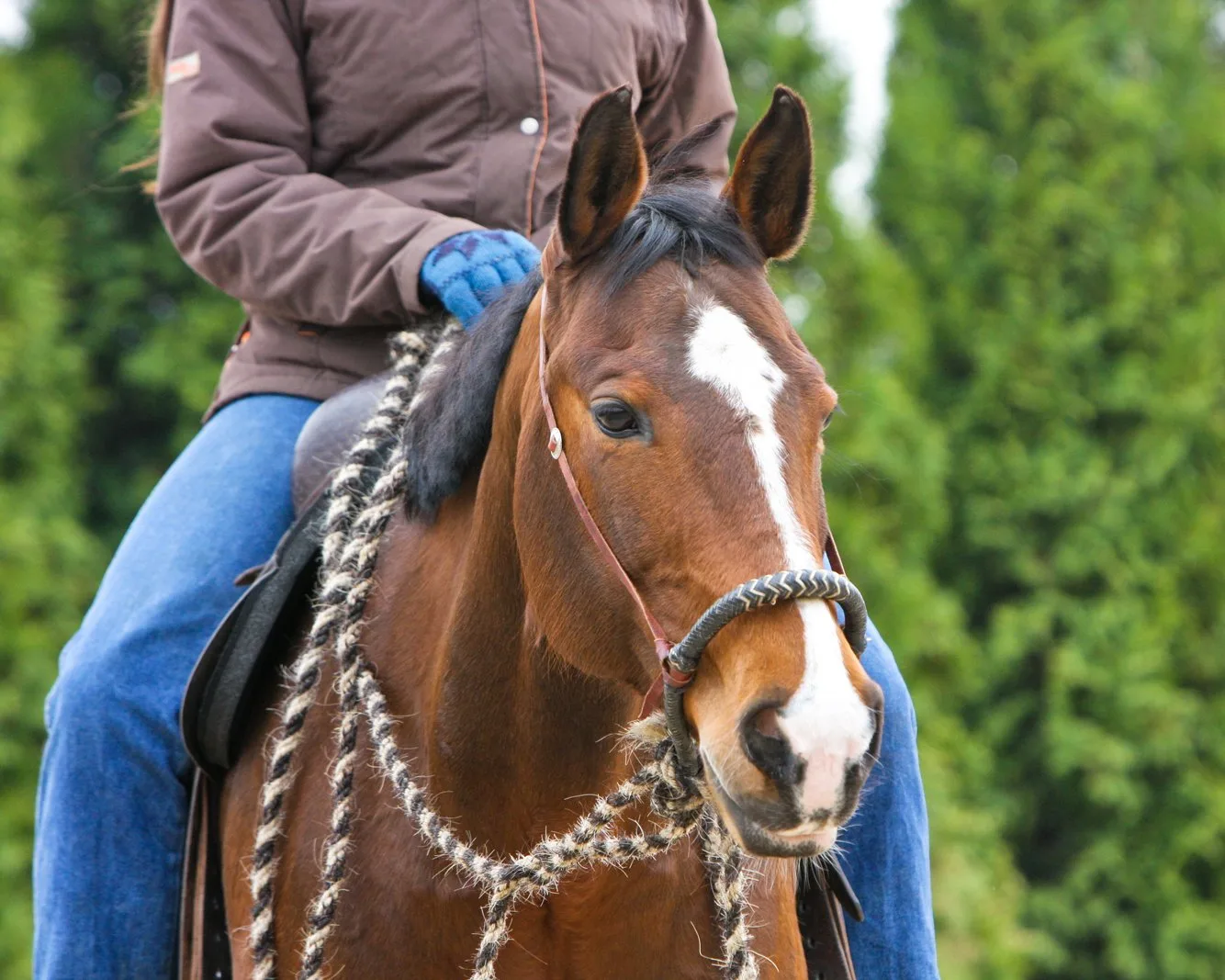A loping hackamore is a piece of horse equipment that can be used in place of a bit and bridle. This type of hackamore is a gentle training tool. It is used by many horse trainers to begin training young horses and is also sometimes used for well-trained trail, pleasure, or even speed event horses.
In this article, you’ll learn more about the loping hackamore, how it’s different from other hackamores, how to use it- and even how to make one!
How a Loping Hackamore Works
A loping Hackamore functions as a type of bitless bridle. Like all bitless bridles (except the war bridle), it uses pressure on the outside of the face to communicate with the horse. Typical bridles use pressure on the inside of the horse’s mouth, via a bit.
Rather than having a mouthpiece, a loping hackamore works through pressure on the nose, poll, and chin. These areas on a horse’s face are very sensitive, so correction from a loping Hackamore can be deceptively sharp.1
The Loping Hackamore in History
A few decades ago, nearly every horse starting training in the American West started using a traditional bosal or a rope hackamore- what we’d today call a loping hackamore. Hackamores became popular because they provided firm control that had no possibility of injuring the sensitive tissue inside of the horse’s mouth.
Back in the days when early training looked exactly like a rodeo bronc ride, it made sense to use a bridle that could not injure the horse’s mouth during those wild first few rides. Today, even young horses are generally started with a gentle bit in their mouth. Because modern horse trainers use gentler, cooperative training methods, there is less risk of injuring a horse’s mouth.
Hackamores have also gotten more complicated over the last century. Mechanical hackamores mechanically translate pressure into intense leverage that can actually cause a great deal of pain to a horse through mishandling the reins. However, a rope hackamore, or loping hackamore, is a gentler tool because it does not use leverage.

Reasons this equipment is used
Horses today may be ridden with a bit, hackamore, or bitless bridle for a number of reasons. These reasons include:
- Some horses (who would’ve been written off and sold down the river by a previous generation) are more docile, agreeable, and trainable when there is no bit in their mouth. (The stallion I owned in the 2000’s was like this- after a traumatic mouth injury from a bit early in training, he never was able to accept a bit but made a sensible riding horse when paired with a loping hackamore.)
- Horses with dental issues can sometimes be ridden with a hackamore when a bit would cause pain.
- Rope hackamores can be used with beginner riders to minimize a horse’s discomfort as a new rider’s hands bounce and bobble.
- Some horse owners simply prefer the gentle action of a hackamore.
Rope Hackamores come to us from the Spanish tradition, so many of the parts of the Hackamore – and even the name itself (probably derived from the Spanish word jaquima – pronounced hak-kee-mah) has Spanish origins.
The parts of a Loping Hackamore:
Bosal:
The Bosal is the nose band of a rope or rawhide hackamore. It goes around the horse’s nose encircling it completely. It might be made of rawhide, leather, horsehair, or rope. The severity of a bosal varies according to the thickness and texture of the bozal. Thin, hard bozos provide a sharper correction than softer, wider versions. When correctly positioned, the Bozo sits farther down on the nose than a traditional bridle’s noseband.
Mecate
Makate is a type of rope – traditionally made from horsehair.
Fiador
On a western hackamore, the fiador is a smaller, thinner rope that passes under the horse’s throatlatch and helps keep the headstall from sliding forward over the ears. Confusingly, “fiador can also refer to the large knot where the reins and an additional long rope are attached to the nose band”1
Headstall
The headstall is the strap passing over the horse’s ear and holding the bosal in the right position.
Reins
Adding reins to Hackamore is unnecessary if a Makate is used- since these double as reins. Reins are generally softer than the noseband – to be more comfortable for a rider.
How Loping Hackamores are Different
The difference between a loping hackamore and a typical bosal style western hackamore is that the loping Hackamore has a softer nose band.2 This helps a rider communicate with their horse without harsh signals. Because of this, the loping Hackamore is popular among many practitioners of natural horsemanship.
Loping vs Bosal Hackamore
Unlike a Boal style hackamore (sometimes called a California style) that you may have seen in Western pleasure classes a loping hackamore is much lighter in both weight and lighter in terms of the pressure that transfers to a horse’s pressure points.3 This type of hackamore offers little in the way of leverage. However, horses that have been trained as yearlings to flex and yield to pressure typically respond well to a hackamore. For some horses, a loping hackamore may stop head tossing.
When most riders think about a western-style hackamore, they imagine the traditional bozal style popularized by the Vaqueros and the Cowboys of the American West. However, a loping hackamore is one example of the spectrum of hackamore types available.
The difference between a loping Hackamore in the bosal hackamore is that a loping hackamore has a relatively soft noseband, while a bosal features a hard noseband that often has a core of metal cord or stiff braided rawhide.
To imagine the difference between a loping hackamore versus the bosal, imagine if someone led you around by the wrist using either a bangle bracelet or a friendship bracelet! The softer, more flexible braided cloth bracelet would be gentler, wouldn’t it?
Loping Hackamore versus a Jumping Hackamore
A loping Hackamore and a jumping hackamore are both versions of gentle bitless bridles. Both of these types of Hackamore are most appropriate for well-trained horses who move off of a rider’s leg and body cues rather than cues from direct reining.
The difference between a loping hackamore and a jumping hackamore, however, is that reins attach to a jumping Hackamore on either side of the face, but on a loping hackamore, both reins attach at a central point under the horse’s chin.
How to make a loping Hackamore
If you know how to make a rope halter, it’s easy to make a loping Hackamore: To make a rope Hackamore you will need a continuous piece of rope about 14-16 feet long and 1/2″ to 5/8″ in diameter (narrow or rope will have a sharper correction, while wide rope offers soft pressure). Form a loop in the rope on the offside, and tie a bow line not on the near side – this forms the front portion of the headpiece and noseband. The leftover rope is then run across and down through the loop on the offside.
- Esterson, E. (2019). The Ultimate Book of Horse Bits: What They Are, What They Do, and How They Work (2nd Edition). United States: Skyhorse. [↩] [↩]
- Cameron, C. (2013). Ride Smarter: On to the Next Level of Horsemanship. United States: Western Horseman. [↩]
- Cameron, C. (2013). Ride Smarter: On to the Next Level of Horsemanship. United States: Western Horseman. [↩]
